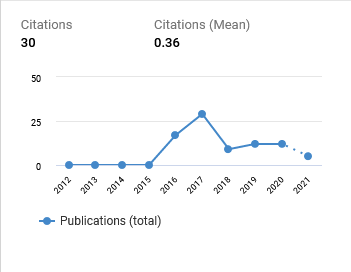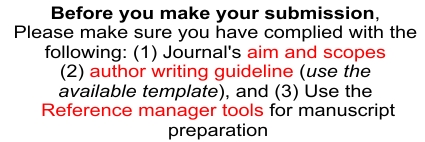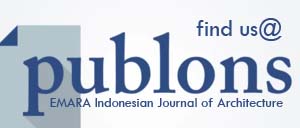Locus Terikat dalam Tarekat: Eksistensi Kampung Khalwatiyah Patte’ne di Tengah Urbanitas
DOI:
https://doi.org/10.29080/emara.v4i1.173Keywords:
village, Khalwatiyah, Patte'ne, tariqa, urbanityAbstract
An early Tasawwuf has already existed since Islam religion was first brought to Indonesia in which Tariqa traditions contributed to the spread of the faith. The Tariqa of Khalwatiyah Samman is one of the Islamic mysticisms which has developed and been in existence until now. The number of the Tariqa’s followers reaches hundred thousand of people spread in various loci including Patte’ne village in Maros Regency, South Sulawesi. The strategic location becomes an urbanity anomaly toward the surrounding integrated area. The Patte’ne village promotes its existential identity as a consistent locus tied to Khalwatiyah Tariqa. The implementation of this can be seen in the spatial pattern of the area, in the cultural values reflecting the activities applied either in daily rituals or annually ceremonial agendas, and in the human resources acted as role models adopted from the Khalwatiyah teaching. The approach of this research uses both descriptive research and a historical approach. The methods of data collecting are surveys, visual materials, and observations. The result of this research indicates that a village will stand valuable if the concept of urbanity remains existent, in the form of both social and economic systems. The implication of those various sectors can create a condition and a balancing role for all the components creating the surrounding area. It demonstrates that the existence of Patte’ne village has become a locus which energizes an urbanity performance, which means that all the available resources have respectively participated so that it creates a mutually symbiotic relationship.
Downloads
References
Darjosanjoto, E. T. (2006). Penelitian Arsitektur di bidang Perumahan dan Permukiman. Surabaya: ITS Press.
Groat, L. N., & Wang, D. (2013). Architectural Research Methods. John Wiley & Sons.
Lindarni, D. A., & Handayani, W. (2014). Transformasi Kampung Kota di Kawasan Segitiga Emas Kota Semarang. Riptek. Riptek, 8(2), 1–12. Retrieved from http://bappeda.semarangkota.go.id/v2/wp-content/uploads/2015/08/1.-Transformasi-kampung-kota-dias.pdf
Makhmud, D. F., Nurhasanah, F., Utami, I. U., Khansha, S., Radnawati, D., & Syahadat, R. M. (2017). Mewujudkan Kampung Bandan Sebagai Kampung Kota Berkelanjutan Menggunakan Pendekatan Asian New Urbanism. Vitruvian, 6(3). Retrieved from http://publikasi.mercubuana.ac.id/index.php/virtuvian/article/view/1540
Malisi, M. A. S. (2015). Tarekat Khalwatiyah. Tasamuh, 4(1), 2015.
Nugroho, A. C. (2009). Kampung Kota Sebagai Sebuah Titik Tolak Dalam Membentuk Urbanitas dan Ruang Kota Berkelanjutan. Jurnal Rekayasa, 13(3), 210–218. Retrieved from http://ft-sipil.unila.ac.id/ejournals/index.php/jrekayasa/article/view/20
Nugroho, A. C. (2010). Spatial Enclosure Sebagai Dasar Penataan Kampung Kota. JA! UBL, 1(1). Retrieved from http://jurnal.ubl.ac.id/index.php/ja/article/view/289
Nurdiani, N. (2010). Pola Pengembangan Rumah di Kampung Kota dan Faktor-Faktor yang Mempengaruhinya. ComTech: Computer, Mathematics and Engineering Applications, 1(2), 1041–1052. doi:10.21512/comtech.v1i2.2663
Wahjoerini, W., & Setioko, B. (2014). Faktor-faktor yang Menentukan Eksistensi Kampung Pekojan sebagai Kampung Kota di Kota Semarang. Jurnal Pembangunan Wilayah & Kota, 10(1), 106–114. doi:10.14710/pwk.v10i1.7637

Downloads
Published
How to Cite
Issue
Section
Categories
License
- Authors retain copyright and grant the journal right of first publication with the work simultaneously licensed under a Creative Commons Attribution ShareAlike License that allows others to share the work with an acknowledgment of the work's authorship and initial publication in this journal.
- Authors are able to enter into separate, additional contractual arrangements for the non-exclusive distribution of the journal's published version of the work (e.g., post it to an institutional repository or publish it in a book), with an acknowledgment of its initial publication in this journal.
- Authors are permitted and encouraged to post their work online (e.g., in institutional repositories, pre-print sites, or on their website) prior to and during the submission process, as it can lead to productive exchanges, as well as earlier and greater dissemination of published work.
































